A closer look into DePaul’s controversial basketball investment, Wintrust Arena — its low turnout, expensive operations, poor team performance — and the new promises for the upcoming $60 million athletic investment.
In recent years, DePaul University’s ambitious investment into Wintrust Arena has been the face of much disappointment from DePaul men’s basketball fans and college sports enthusiasts alike. Despite the administration’s high hopes and the substantial outpouring of resources into the project, the team’s recent overwhelming underperformance has posed a major setback for DePaul Athletics’ future ambitions.
Before the glitz of a downtown arena, the DePaul Blue Demons basketball team had modest beginnings, calling the university’s old theater building, nicknamed “The Barn,” home for three decades. By 1956, the team had their first facility upgrade — the freshly built $2 million Alumni Hall located on the Lincoln Park campus.
Former university president Rev. John R. Cortelyou, C.M., touted the 1980 move into Allstate Arena as a solution to Alumni Hall’s lower capacity as fan interest grew. So, by 1980, the men’s team moved into the larger Allstate Arena in the suburb of Rosemont – 15 miles from Lincoln Park. Allstate, home to DePaul men’s basketball for over 30 years, drew crowds as great as 17,000 fans in the glory years of the ‘70s and ‘80s.
By the end of their time at Allstate in 2017, the team’s wins and game attendance had declined. The university wanted to bring fans back to Chicago and decided to move into what they thought would be a more lucrative deal. This was the decision to enter into a public-private partnership with the Metropolitan Pier and Exposition Authority to build a brand-new, 10,387-seat arena located in the South Loop – Wintrust.
The big dreams and cost of Wintrust Arena
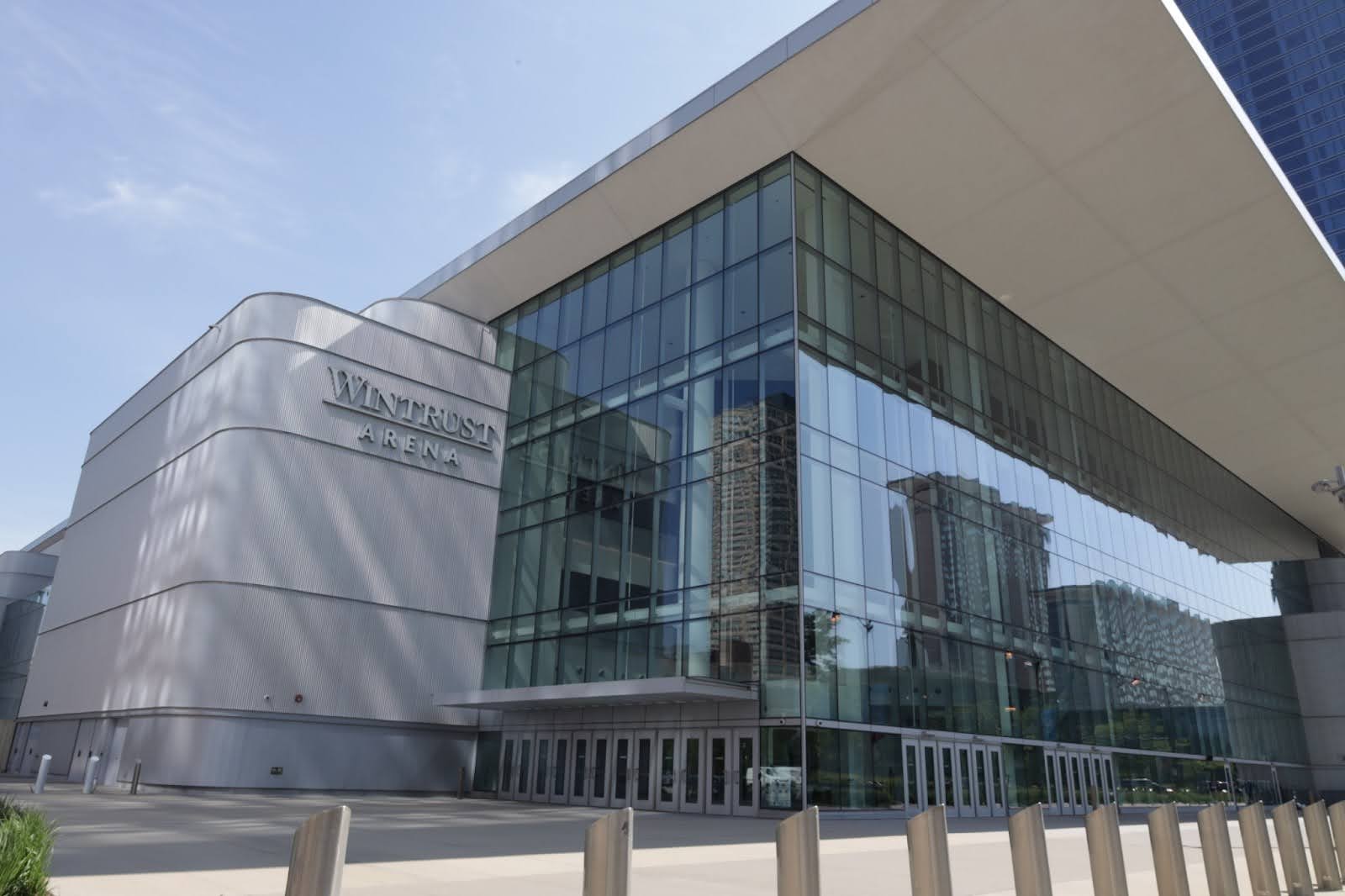
Wintrust Arena located on Cermak Road, May 22, 2024. Photo by Alexandra Murphy.
As conversations about a new home for the Blue Demons began, DePaul’s former president Rev. Dennis H. Holtschneider, C.M., told the DePaulia: “We believe more students will attend if the distance and time to the arena is shortened. We also believe that a new arena located in Chicago will strengthen our ability to recruit the finest talent to play at DePaul.”
Rev. Holtschneider declined to comment on the development of Wintrust Arena for this story, saying that since he ended his tenure as DePaul’s president in 2017, he no longer speaks on behalf of the university.
DePaul entered into a lengthy 50-year lease for the new arena at the end of 2015, and in 2016, Wintrust signed a 15-year naming rights deal with the university. The arena would be closer than Allstate Arena, and the university saw this as a valuable investment and opportunity to rebrand the team with hopes to attract more of an audience.
For the shiny new arena, DePaul paid a flat rate of $82.5 million — splitting cost with the Metropolitan Pier and Exposition Authority, which paid $82.5 million in levied tax dollars. In addition to hosting the university men’s basketball games, the arena would also serve as a home to the Chicago Sky and as a venue for other events, like concerts.
This agreement also came after Rosemont allowed the Blue Demons to play rent free and the university declined a 10-year offer to play rent free at the United Center located in the Near West Side neighborhood. To build Wintrust Arena, DePaul paid the original flat rate, while also agreeing to pay rent over the course of the 50-year lease.
According to a 2013 New York Times Article, the university would have to pay $25,000 a game for men’s home games and $7,500 for women’s games. DePaul Athletics Communications Director Courtney Day confirmed this is the correct figure for men’s and women’s home games, adding that there is also a $20,000 cost for each commencement ceremony.
In the first six seasons at Wintrust Arena, DePaul paid an estimated $2.5 million in rent for the men’s team and $472,500 for the women’s team based on the number of games played each season. Due to the pandemic, graduation has only been held at Wintrust for four years — with an estimated $460,000 in total commencement rent.
DePaul Athletics declined to disclose whether COVID-19 non-attendee game rental rates varied from the standard rate. Estimates were made by applying the standard rate to all games.
Overall, it is estimated that DePaul has paid $3.4 million in combined rental costs. Throughout a 50-year lease, this number is expected to accumulate to a much larger figure.
At the time of the deal, Rev. Holtschneider said revenue from the sale of the naming rights to Wintrust would help pay for arena construction costs. According to the DePaulia, the university estimated that its naming rights deal with Wintrust “…could pull in $22 million over an undisclosed period of time.”
After repeated requests and follow-ups, DePaul Athletics declined to answer further financial questions related to Wintrust Arena. These include questions about the outcome of the naming rights deal and whether or not the university has profited from its multimillion-dollar investment. DePaul Athletics also declined to share revenue figures from corporate sponsorships, fundraising and ticket sales.
Taylor Stapleton, DePaul’s Executive Associate Athletics Director for Revenue Generation & Strategic Initiatives, did share how the athletics department feels about the arena, saying in an email: “DePaul Athletics is extremely satisfied with the investment in Wintrust Arena. It is a state-of-the-art facility that is among the best in the BIG EAST Conference and nationally.”
14 East also reached out to Wintrust Manager David Kennedy for comment on the building of Wintrust and specifics about the construction of the arena, but he declined to comment.
During the time of construction, the arena received much criticism from the public, considering the project was being heavily financed by a split with taxpayers, following the team’s recent underwhelming performance.
The Chicago Tribune reported that Wintrust Arena would “feel like a mini NBA arena,” and at DePaul’s opening game against Notre Dame, it brought anticipated success with a near sold-out arena with more than 10,000 attendees. Although the game was reported by the Tribune to reach over 10,000 attendees, according to 14 East’s analysis of MPEA records, there were only 7,389 attendees.
In recent years, attendance at Wintrust began to take a major turn for the worse compared to the team’s prime at Allstate. While the COVID-19 pandemic played some role in the low attendance of the 2021-2022 season, it was not worse than the 2018-2019 season, which welcomed even fewer fans to Wintrust.
The investment in Wintrust came with Rev. Holtschneider’s hope for an increase in student attendance when playing at Wintrust, which historically fell short of projections. Throughout the first six seasons at Wintrust, the men’s basketball team only reached 7,000 attendees one other time, four seasons later, in 2023.
As a private institution, DePaul has the choice not to disclose its financial details to the public. Without information regarding their profits, the investment’s success is unclear.
In August 2023, the university announced its campaign for a $60 million athletic facility and renovation. Now, DePaul’s Athletics Director DeWayne Peevy has announced his own idea of how the athletic facility will impact the university, saying in a university-wide email, “While these projects are certain to drive athletic success, more importantly, they will enhance national visibility, brand awareness and affinity for DePaul, each in alignment with the university’s overall goals to boost enrollment, student success, and philanthropic support.”
To better understand DePaul’s modern basketball investments, we will review historically low attendance rates, coaching issues, the vision and budget of the new facility, community opinions on new development and next season’s outlook.
Half-full or half-empty? DePaul paid millions in rent to an arena it hasn’t filled
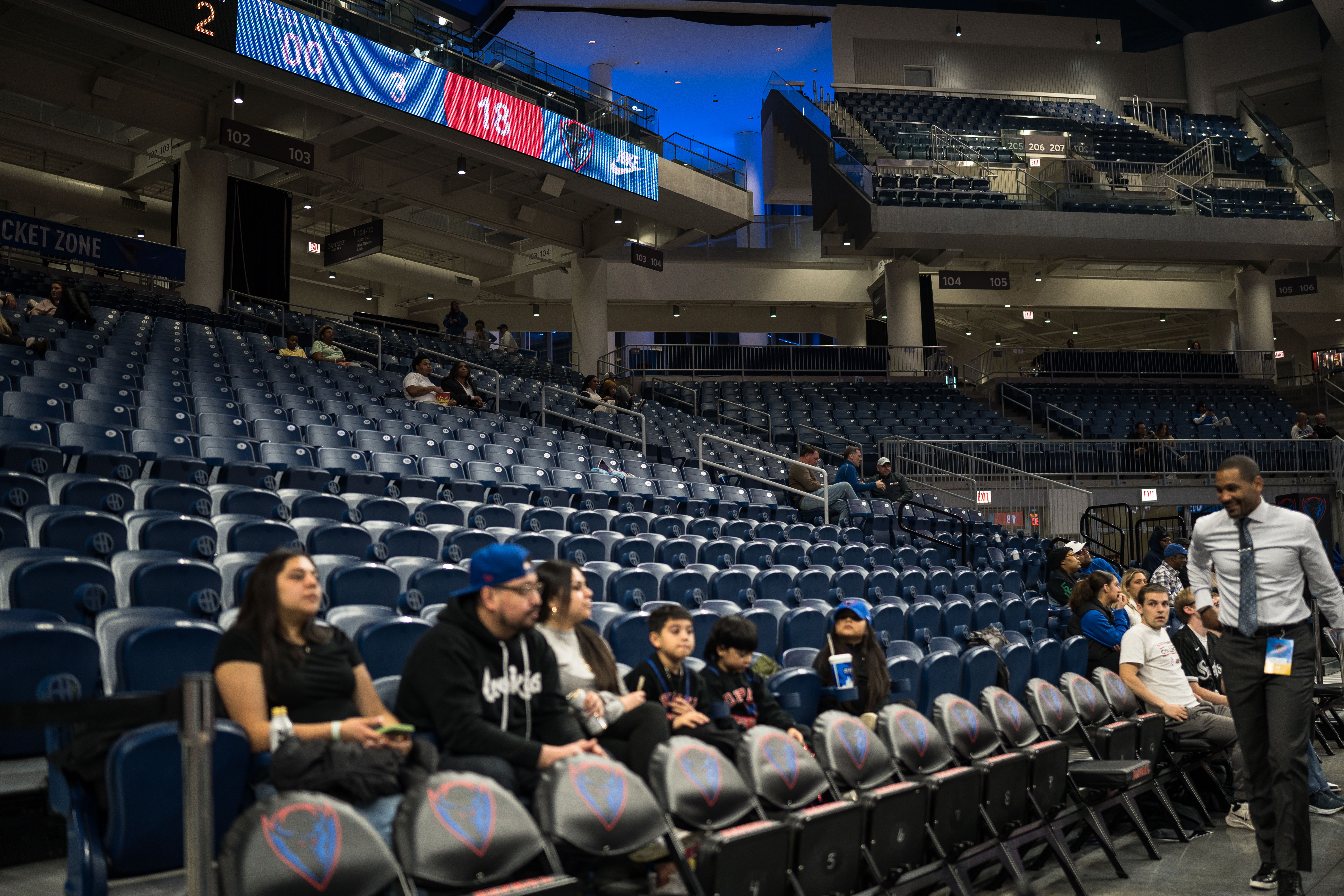
DePaul home game against Seton Hall on January 30, 2024. The DePaul Blue Demons lost to Seton 39-72. Photo by Andy Thompson.
With a shift in performance, men’s basketball started to see a notable decline in attendance, with attendance at Allstate in 2014 dropping 27% below the previous year, according to Crain’s Chicago Business. The team finished below 2,000 fans per game.
Attendance for Wintrust, in part funded by taxpayer dollars, has majorly trailed projections made by the MPEA in 2017 that the arena would be bringing in a much larger audience of 9,000 seats filled.
According to attendance records obtained by 14 East through the Freedom of Information Act, DePaul men’s basketball attendance has remained low since opening in 2017. The majority of the games haven’t been able to fill up even a quarter of Wintrust Arena’s 10,387-seat capacity in recent years. Attendance records reviewed by 14 East do not include the most recent season.
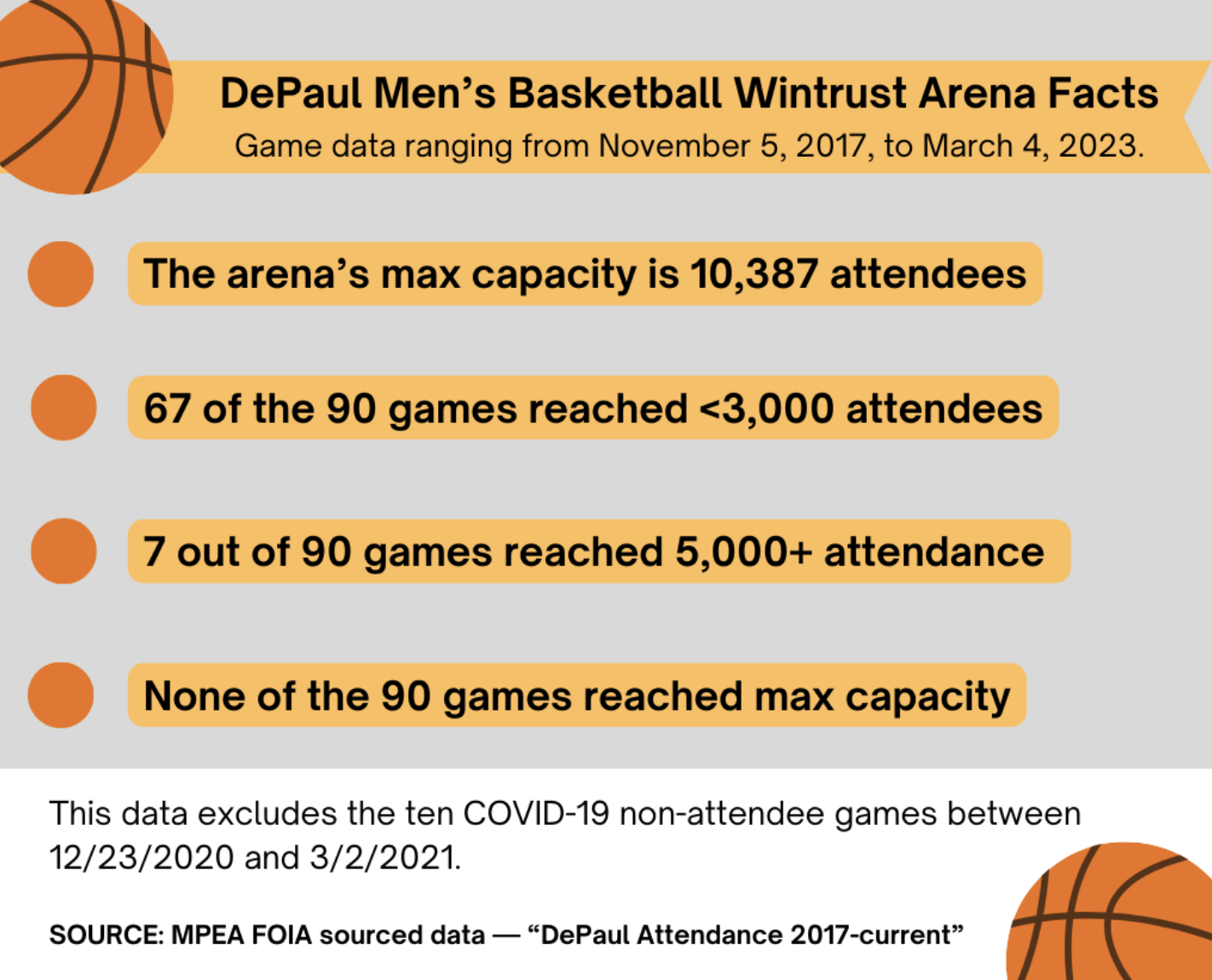
“DePaul Men’s Basketball Wintrust Arena Facts.” Created in Canva. Graphic by Billie Rollason.
Records also show that out of all DePaul men’s basketball games played since 2017, most of the games that had more than half of the seats full were played against neighboring universities like Notre Dame, Marquette and Loyola with a location relatively convenient for students from other universities to commute to the games.
The men’s most widely attended game at Wintrust was played against Marquette in 2023. It was the first and only game to sell out. However, the arena only reached about 75% capacity with 7,514 attendees. This is one of only two games in the first six seasons at Wintrust Arena where the men’s basketball team saw attendance above 7,000.

“DePaul Men’s Basketball Games with >50% attendance (Nov. 2017 to March 2023).” Generated in Google Sheets and edited in PicMonkey. Graphic by Billie Rollason.
When asked about the drastic decline in attendance in recent years, Athletics Director Peevy said he fully believes this rate will have a drastic turnaround with a new coach hire and the building of an improved training facility.
“If we get this head coaching hire right, we could easily get to a point where we’re packing 7,500 to 10,000 people in the arena every night,” Peevy said. “I don’t think we’re very far from that.”
After the men’s team performance took a dive at the end of the Ray Meyer era, so did fan attendance. The men’s basketball team had 37 successful seasons under legendary head coach Ray Meyer from 1942-84 before his son Joey Meyer took over. Joey Meyer went on to lead the team to seven NCAA tournament appearances in the span of 13 seasons until he was fired for poor performance. DePaul’s team would continue see-sawing in its success with three different coaches in the span of a decade.
A timeline of consistently poor coaching results
Since Joey Meyer was let go in 1997, the team has had only six winning seasons. Former college basketball coach and player Pat Kennedy, who compiled a 124-60 record while coaching at NC State, stepped in next as DePaul men’s basketball head coach. During his time with the men’s basketball team, he was able to take the team to the NIT and NCAA tournaments in his second and third seasons. However, after the Blue Demons lost 15 of 17 games in 2002 and failed to qualify for the Conference USA Tournament, it was only a matter of time before Kennedy made the decision to resign.
Kennedy was succeeded by coach Dave Leitao six weeks later. He had more success during his initial three-year stretch from 2002 to 2005, guiding the Blue Demons to a 58-34 record. Leitao’s first term was the most successful the team had been since Joey Meyer was let go in 1997.
At this point, DePaul left Conference USA and was accepted into the Big East Conference in 2003 for the 2005-06 season, and Jerry Wainwright was hired.
Out of the first five seasons after DePaul entered into the Big East conference in 2005, they only had one winning season under Wainwright. By the time Wainwright was fired after losing 22 straight regular-season games, the team was left in limbo and the following coach would be left to pick up the pieces.
Known for his reputation to turn programs around at Clemson University, Oliver Purnell was hired as DePaul’s head coach in 2010 with the goal to make DePaul basketball prominent again and to bring the team back to the NCAA tournament for the first time since 2003-04. This did not end up being the case, and after posting a 54-105 overall record and bringing the team to 15-65 in the span of five seasons, Purnell made the decision to resign.
When Purnell resigned, Leitao was asked back as head coach in 2015, but he did not have the same success in his second term. In his second go-around with the team, they finished 5-14 overall and 2-13 in last place for Big East play.
The 2003-04 season under Coach Leitao was the last time DePaul hit a No. 1 ranking in the Men’s Conference USA. This year, DePaul sits in last place in the Big East amid the chaos of the mid-season firing of Coach Tony Stubblefield. The season closed with three wins and 29 losses.
A brand new $60 million athletic investment
Given the low numbers of attendance and recent poor performance, DePaul has chosen to invest and build a new athletic training facility at the 2300 block of North Sheffield Avenue. The university will also be renovating the Sullivan Athletic Center and McGrath-Phillips Arena. These projects combined are set to cost approximately $60 million.
The new training facility will include a student-athlete recovery area, a team dining space, new sports medicine treatment spaces, volleyball courts and a multi-purpose recruiting room.
The first part of the project will cost $10 million, and “we’re pretty close to that,” Peevy said in February in regards to the athletic department’s fundraising efforts.
Peevy also said most of the funds would come from private donors. However, he explained DePaul Athletics has not yet reached its donation goal.
In an email from Day, she said: “The estimated total of approximately $60 million for both capital projects will be funded primarily through donor gifts but will also rely on corporate gifts and naming rights. $20 million in hand is required to begin construction on the basketball practice facility project.”
This comes one year after DePaul’s $56.5 million budget gap in March 2023, resulting in cuts to departments across the university — including the Office of Multicultural Student Success — along with faculty not having their contracts renewed.
DePaul student Milan Martinez said the university is doing fine in its current facilities and believes the funding could go into other areas of the university that students care about.
“I don’t think that people came to DePaul cause it’s a huge sports school,” Martinez said. “They are here for what the school values and teaches and it confuses me how this will contribute to furthering these goals.”
Peevy said the old facility did not have enough weight rooms, machines or private tutoring rooms throughout the facility for the basketball team. This new three-story building, he said, will include weight and training rooms, lockers, lounges, gymnasiums and an annex.
“It’s not necessarily about our student-athletes not being talented enough, but we got to give them the best opportunity to train,” Peevy said.
Neighbors question who is being left out of the conversation
During a town hall meeting held in November 2023, both alumni and community members voiced their opinions that the fundraising money should be allocated to other areas of the university. Peevy, on the other hand, explained how having a new facility and a better team could help make DePaul look more attractive to prospective students.
“It’s the one lever we can play right now that can really impact the amount of people that apply to go to this university, which means more people are willing to pay and means that it affects the tuition revenue,” Peevy said.
Peevy also expressed a desire to work with DePaul’s College of Communication, giving students the opportunity to promote the basketball team.
While Peevy said that the new facility will bring in more student enrollment and increase university revenue overall, Melissa Macek, a Lincoln Park business owner, approached the microphone during the town hall meeting to question how DePaul athletics is benefitting the majority of the student population with the new facility.
Macek explained that she works with many DePaul students, some who tell her they cannot afford rent in the Lincoln Park neighborhood.
“I really do think you need to think about the fact that you’re tearing down affordable housing on your campus. What percentage of the students are athletes that are going to actually use this building versus your total student population?” Macek asked.
While Peevy and other leaders of the project spoke about how the project would bring revenue for the entire student population, Macek found holes in his hopefulness.
“For every one success story there’s five to 10 other campuses out there that are pouring just as much money that never go anywhere,” she said. “You are putting all this effort into one percent of your student base, and you’re ignoring the other 99%.”
Butler Adams (left) and Melissa Macek (right) speak during DePaul’s town hall meeting on November 9, 2023, about why they do not support the building of the new basketball facility. Photos by Cary Robbins.
Neighbors and alumni members at the town hall also expressed concern over how the new facility will destroy historic and beloved buildings in their community.
“I must agree with a lot of people in the neighborhood who are very, very disappointed about the demolition of the older buildings across the street,” said Butler Adams, an alumnus of DePaul. “I say that as a lover of architecture and as someone who graduated from this school last year and walked across that stage. … In terms of this being my school, I’m a bit disappointed.”
Peevy and Peter Coffey, DePaul’s Associate Vice President of Community and Government Relations, said during the press conference that DePaul Athletics spoke with Landmarks Illinois “and other groups” to ensure that the buildings are not historic.
However, Bonnie McDonald, President and CEO of Landmarks Illinois, walked up to the microphone to say that the buildings are historic Chicago row houses and the university has not been transparent about the teardown plans.
“Demolition should be the last resort,” McDonald said.
After the town hall meeting in the Fall, DePaul redesigned plans for the facility in April with the latest plan still including the demolition of the century-old row houses dating back to the 1890s. The four buildings still set to be demolished are located in DePaul’s courtyard building located at 2300-2302 N. Sheffield Ave., which houses about 40 on-campus student apartments.
Within the new plan, while the historic buildings would be torn down, DePaul committed to preserving and landmarking other buildings on campus, including Cortelyou Commons, Byrne Hall and O’Connell Hall.
Although DePaul committed to these changes, some people who attended the committee meeting were still split on the new preservation plans and continued questioning the need of the new facility on campus similar to the town hall in the Fall.
Ald. Timmy Knudsen (43rd) expressed to the public that while the new revised plan by the university shows promise, there would still need to be more community questions answered before moving forward with the development.
Desperate for a solution
Despite the decline in men’s basketball’s recent performance, DePaul Athletics remains hopeful they will be able to meet their goal of getting adequate funding for the new training facility and start construction soon.
The DePaul men’s basketball team has experienced some recent turmoil — including the recent mid-season firing of previous head coach Stubblefield and the hiring of new head coach Chris Holtmann in March. While some people are excited for Holtmann to take over the position, other critics are concerned about Holtmann’s previous “several disappointing seasons.” Holtmann was fired due to his performance as Ohio State’s basketball coach in February, according to the AP.
Peevy has expressed hope that Holtmann will improve the team, saying he has wanted to hire Holtmann for a while.
“I think the first time I started kind of watching Chris was actually when I was at Kentucky,” Peevy said during a press conference. Peevy was deputy director of athletics at the University of Kentucky, where he worked for 12 years until DePaul hired him in 2020.
Peevy is not the only one who believes in the program and Holtmann’s ability to turn it around. Joey Pollizze, a DePaul alum and DePaul men’s basketball beat writer, believes Holtmann was a fantastic coach hire to help rebuild the program.
“Holtmann has success winning. He is the right leader for this job. And, I am confident writing for the team, covering the team and as a DePaul fan that Holtmann can get DePaul to where they want to be,” said Pollizze.
In an email from Stapleton, he said: “We are excited about the future of the program with the recent hire of Head Coach Chris Holtmann and the roster he and his staff have assembled. The current men’s basketball roster has 12 scholarship players who have signed for 2024-25.”
As of June 5, Day confirmed that currently none of the 2023-2024 players will return next season. This change will allow Holtmann to develop the men’s team from the ground up.

DeWayne Peevy, DePaul athletics director, speaks with community members at the DePaul town hall meeting on November 9, 2023. Peevy spoke about how the new training facility will improve retention rates and help all departments on campus. Photo by Cary Robbins.
With the amount of money going into building the new facility, Peevy said he hopes it will benefit other departments of the university as well.
“The data shows in private schools if you have a basketball team that makes a tournament, more times than not over a five-year period, that it raises applications,” Peevy said. “It raises the enrollment which affects net tuition revenue, that doesn’t even go directly in athletics. It helps the university.”
Across the country, tuition revenue has shown a decrease among universities in recent years. From Fall 2014 to Fall 2023, the number of students enrolled at DePaul declined about 10%, according to DePaul’s Institutional Research & Market Analytics. The university is also largely dependent on tuition revenue as its major source of income, with more than $426 million of revenue coming from net tuition and fees net of student aid in the fiscal year ended June 2022, according to DePaul’s most recent Form 990 tax filing with the U.S Internal Revenue Service.
The expensive modern pursuit for basketball glory
The original success of DePaul men’s basketball was crafted out of simple resources and invested coaches at The Barn. Then, the $2 million (equivalent to ~$23 million in modern day) financial investment of Alumni Hall served as a place for the university’s athletic programs to grow in Lincoln Park. The basketball team’s new home had 5,300 seats.
Eventually, the university would expand its venue and make the move to Allstate Arena. Regardless of the 15-mile commute from Lincoln Park, people still sold out and showed up to the 18,500-seat arena to see the Blue Demons in their glory years. However, the fan momentum would not last forever, and Allstate would face low attendance adjacent to the team’s poor performance.
After years outside the city, Rev. Holtschneider shared his belief that a downtown arena could increase student attendance and basketball talent. The DePaulia reported that “one of the primary motivations” of the university’s Wintrust Arena investment was complaints from students about the long commute to Allstate Arena.
Now, after years of multimillion-dollar investments at Wintrust, DePaul continues facing the challenges of filling the arena, improving the men’s basketball performance and winning back the hearts of Chicago sports fans.
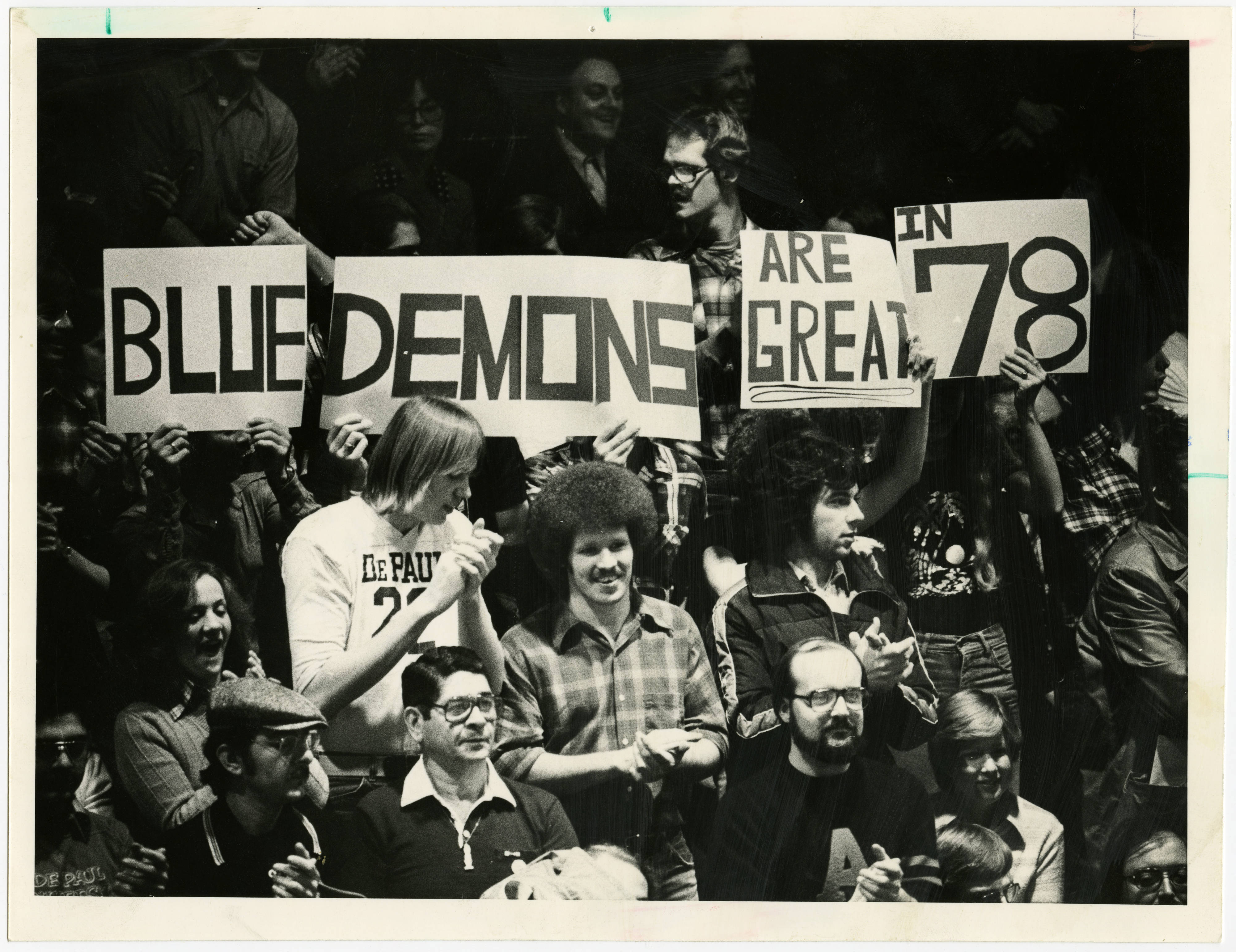
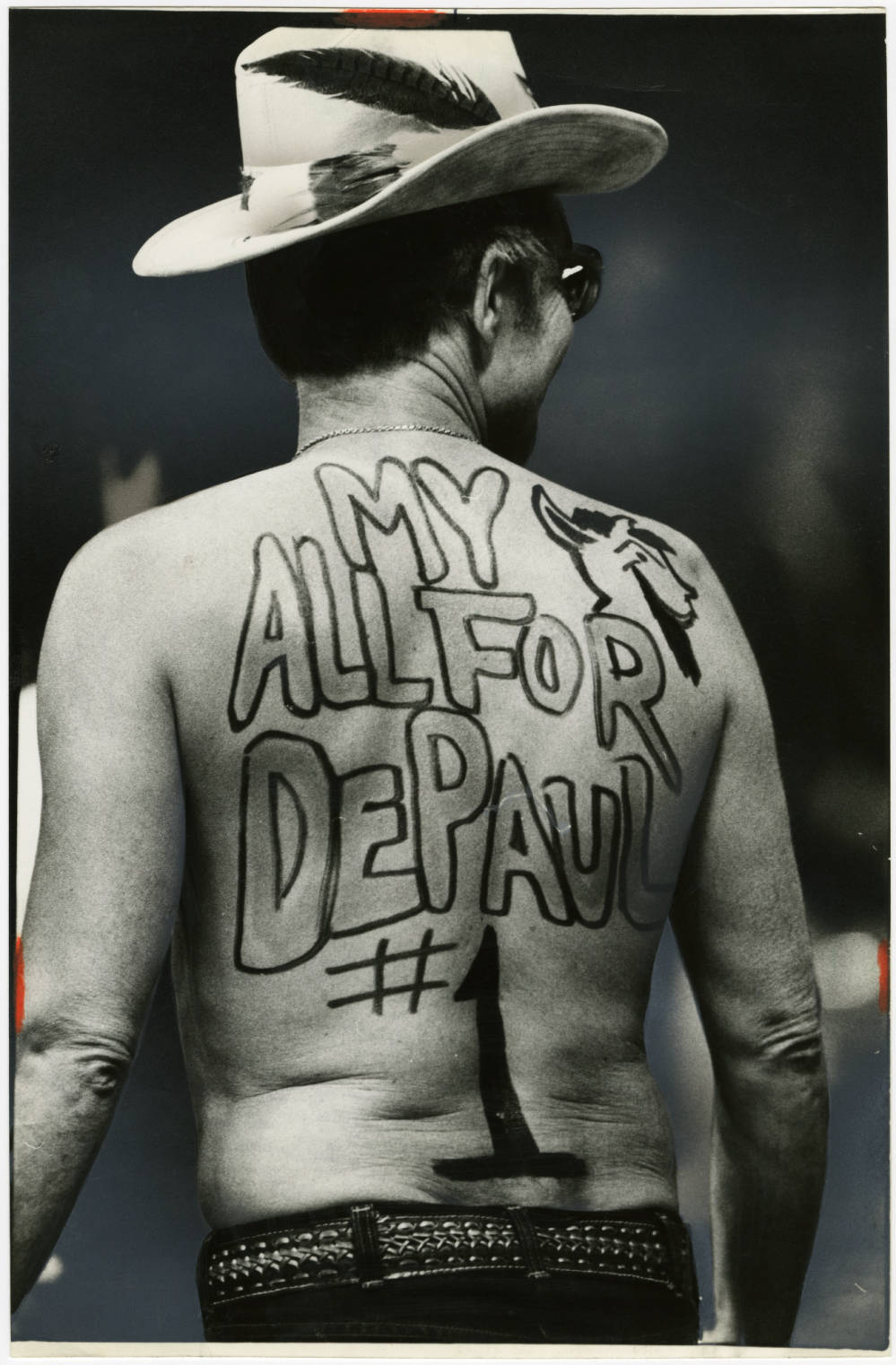
IMAGE LEFT: Men’s basketball fans at Alumni Hall on January 7, 1978, where DePaul would beat Loyola 93 to 73.
DePaul University Photographs. Volume65/BasketballFans_1978,1980-1999_001.tif. Special Collections and Archives, DePaul University Library, Chicago, Illinois. Bob Langer/Chicago Sun-Times (LINK)
IMAGE RIGHT: A Blue Demon fan on February 3, 1982, celebrating at Rosemont Horizon’s (currently known as Allstate Arena) “banner night” with his sign on his back. In this game, DePaul’s men’s team beat St. Joseph in overtime 46-44.
DePaul University Photographs. Volume65/BasketballFans_1978,1980-1999_003.tif. Special Collections and Archives, DePaul University Library, Chicago, Illinois. Bob Langer/Chicago Sun-Times (LINK)
Even with a downtown location, none of the DePaul basketball games played in their first six seasons at the arena garnered maximum capacity attendance. And only seven games have reached at least half-full attendance.
DePaul’s continued struggle to fill seats raises the question — was this expensive arena enough to increase public interest as the administration had originally hoped? Six years’ worth of low attendance rates would argue no.
This year the team endured its worst season since 1996-97 and made unfavorable history by being the first Big East team to lose all 20 conference games. Next season, Holtmann will be coaching a brand-new set of players.
With the Wintrust investment in DePaul’s rearview, all eyes are on the development of the new athletic facility. Peevy says the facility will bring athletic success, which could result in higher student enrollment and in turn larger university revenue. On the other hand, students and community members remain skeptical of the new promises being made.
While a better basketball facility and team could excite prospective students, it’s still a waiting game to see if this will result in better performance and, in turn, what DePaul Athletics says will bring an increase in enrollment.
The athletic facility is expected to open in 2026, which leaves the new administration with two seasons to improve the team’s performance and raise fan morale before opening its doors. Whether or not DePaul’s men’s basketball team can find new success and bring in more fans, Wintrust Arena will be waiting with more than 10,000 seats to fill.
Corrections from 06/09/2024: Before moving into Wintrust Arena, DePaul continued playing at Allstate Arena until 2017. In a previous version, when talking about the arena move it referred to the end of the DePaul/Allstate contract in 2015 rather than their moving date.
Additionally, DePaul hit No. 1 in the Men’s Conference USA in 2003-04. A previous version said the 2003-04 season was the last time DePaul hit a No. 1 ranking in the Big East. These have been corrected.
Attendance at DePaul’s basketball games did not steadily decline since 2015. In a previous version, it said attendance steadily declined. That statement was removed.



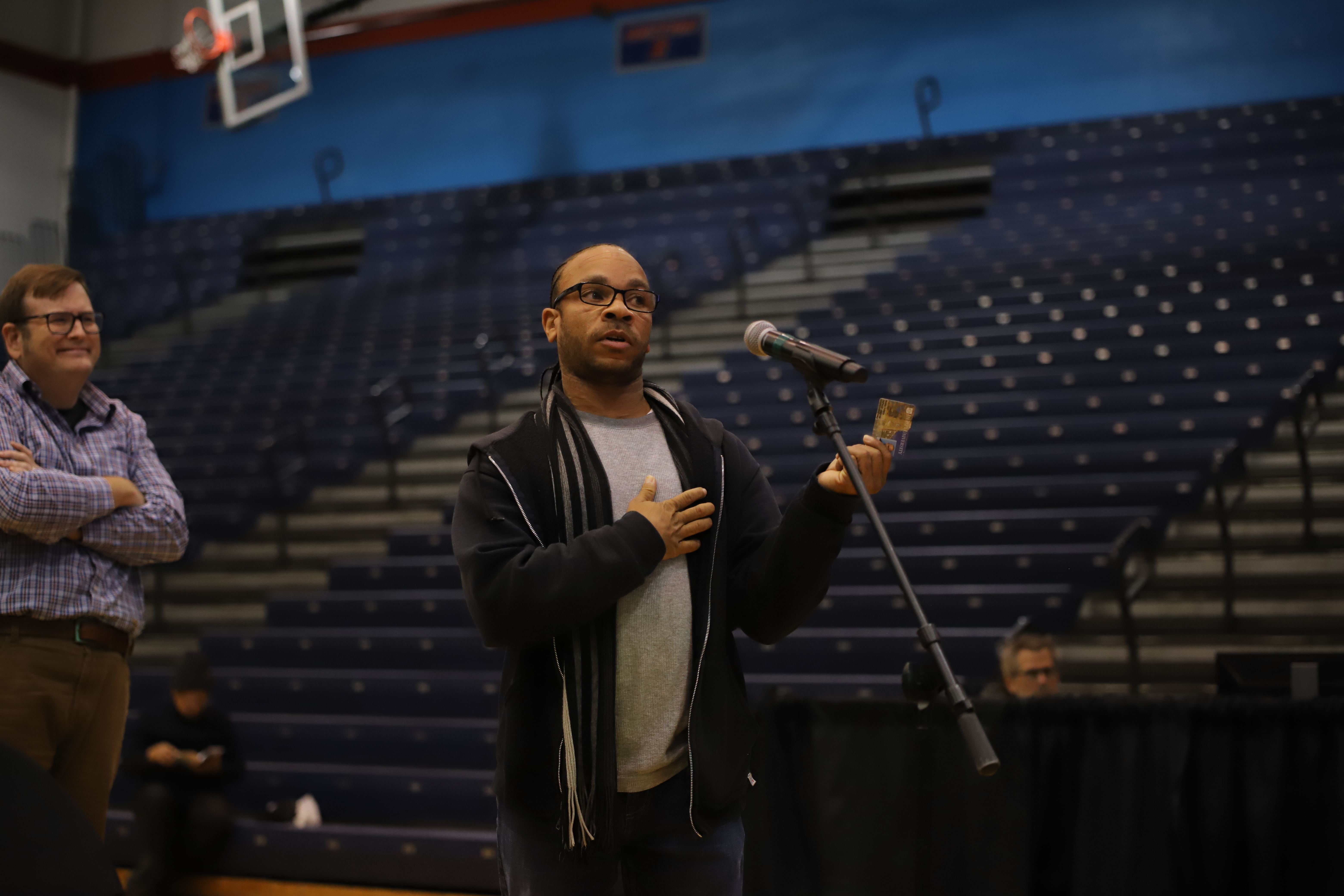
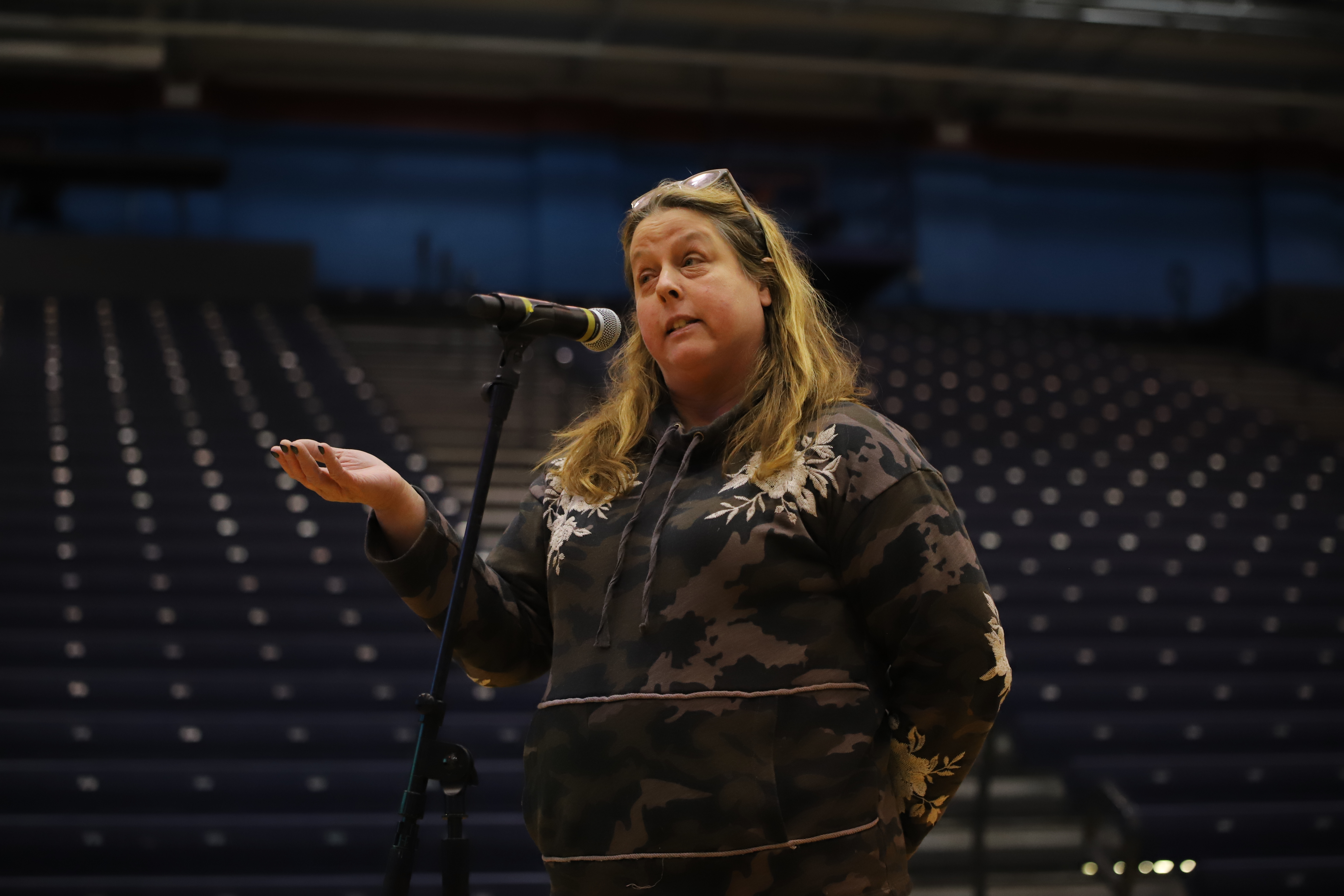

NO COMMENT